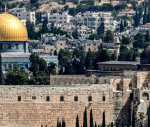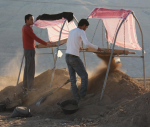You are here
The Palestinian-Israeli conflict — a stark reality check
Oct 21,2023 - Last updated at Oct 21,2023
It is time to confront a bitter truth: The Palestinian-Israeli conflict, a diplomatic puzzle that has perplexed the world for half-a-century, has reached its endpoint. It is not that a resolution has been miraculously discovered. In fact, quite the opposite has occurred. The injustices and insecurities that have scarred the lives of people living between the Jordan River and the Mediterranean Sea have become so deeply entrenched in the fabric of daily existence that no diplomatic framework can offer a remedy.
This reality, however, does not affect everyone equally. It leaves some in a more favourable position than others, leading to a degree of satisfaction for many. Yet, even those who feel secure cannot help but worry, not so much about their own lives, but about the world that awaits their children and grandchildren. Meanwhile, many remain stateless, their freedom of movement curtailed, subject to heavy-handed policing and struggling to meet the immediate needs of their families rather than planning for future generations.
The global landscape continues to undergo swift territorial transformations. New states are emerging, old ones are fracturing and globalisation is challenging established notions of territorial sovereignty within enclosed boundaries. These processes have significantly shaped the world's political map over the past decade. On one side, we have witnessed a redistribution of political power, notably due to the dissolution of the Soviet Union, along with conflict resolution endeavours in regions such as Southern Africa, Northern Ireland, Bosnia, the Czech Republic and Israel/Palestine. On the other, the structural impacts of globalisation have redefined the flow of people, goods, corporate markets, information and ideas, testing the traditional norms of sovereignty. This dynamic geopolitical landscape serves as a stark reminder that the world's political map is not a static outcome of political processes but a constantly evolving entity.
The transition from active conflict and violence to "peace processes" necessitates a profound shift in mindset for the parties involved. It requires them to recognise, legitimise and engage with one another. The Palestinian-Israeli conflict serves as an invaluable case study for political geography and conflict resolution, offering insights into territory, territorial change and the tangible and symbolic dimensions of territorial conflict. The deep-rooted sense of attachment that groups feel to their land, nurtured through territorial socialisation, underscores the complexity of territorial disputes.
While discussions often revolve around historical rights and claims, tangible geopolitical realities hold significant sway over the shape of peace agreements. The establishment of settlements as a means of asserting territorial control has been a central focus in the Arab-Israeli conflict, highlighting the interplay between symbolic rhetoric and geopolitical realities. Acknowledging the settler-colonial nature of the conflict is essential for redirecting the path toward reconciliation between Israelis and Palestinians. Any endeavour at reconciliation must commence by acknowledging the power dynamics and asymmetry between the colonised and the colonizer (occupied and occupier), with the aim of transforming these structures into ones based on equality and reciprocity within a new democratic political order.
In a world grappling with complex geopolitical challenges, the Palestinian-Israeli conflict stands as a stark reminder of the urgent need to address deep-rooted conflicts. The time has come for a genuine reckoning with the status quo, recognising that the path to peace and stability lies in tackling the root causes and forging a future founded on equity and cooperation. The world must seize this opportunity to shift from decades of impasse to a fresh approach focused on justice and common prosperity. The world should acknowledge the two-state solution as the mere solution to defuse this current conflict in Gaza.
Practically, Israel is striving tirelessly to put an end to the two-state solution by expanding the scope of settlements in the occupied West Bank, particularly in occupied East Jerusalem, and continuing the series of Judaisation efforts it is vigorously pursuing. According to figures and data from the Palestinian Wall and Settlement Resistance Authority, the number of settlers in the West Bank, including Jerusalem, has reached 726,427 settlers, distributed among 176 settlements and 186 settlement outposts (nuclei for settlements), including 86 agricultural pastoral outposts, as of the beginning of 2023.
The two-state solution remains the only viable option to meet the legitimate aspirations of both Israelis and Palestinians for security, independence, recognition, and dignity. From this perspective, one should define what is the two-state solution: Borders based on the June 4, 1967 lines, with an agreement on the exchange of equivalent lands; security arrangements to preserve the sovereignty of the future Palestinian state and ensure the security of Israel; a just and equitable solution to the refugee problem agreed upon by all parties; and arrangements making Jerusalem the capital of both states. In this particular context, it is commended to adopt the Arab Peace Initiative of 2002.
The fundamental message after the Gaza-Israel military conflict erupted a few days ago is that it is unacceptable to continue promoting and discussing this solution without practical steps and commitment from the permanent members of the UNSC. It is either implementing this solution immediately to demonstrate the reality of their intentions and the seriousness of the proposal, or seeing what we are witnessing at present.

- Popular
- Rated
- Commented
Oct 04, 2024
Newsletter
Get top stories and blog posts emailed to you each day.












